
Tips to Produce Persuasive Legal Graphics
Litigation graphics can be created with PowerPoint, Prezi, printed on trial board, Elmo or litigation timeline-specific software. Whatever be the platform, creating convincing graphics can contribute greatly to trial presentation.
- While creating charts in word, use the command ‘insert shapes’ to place elements of a timeline. Events should be placed at appropriate places by inserting text boxes.
- Save the complete file in PDF format for a crisp, precise look. Content will be much clearer even when it is projected onto a 4’x6’ board or onto a 10’ screen.
- Timelines typically show events in the order in which they occurred, that is, on a horizontal, chronological scale. That’s why automated timelines should be avoided when you create graphics. Carefully handcraft the timelines by customizing the text boxes in a way that the judge and the jury clearly understand the manner in which events took place.
- There are no specific rules that charts and timelines have to be on the same page. But except in special cases, this is a preferred pattern as it can be difficult to understand the relation between events if they are spread across four or five pages. Connections between events can be understood properly if they are included on the same page.
- The structure of the graphics, the amount of content and depth of information should be customized according to the requirements of the audience (jury, judge, and arbitrator). It should focus on the information that needs to be communicated.
- The message, tone and emphasis of the graphical design should be refined, similar to presenting an argument in writing. The graphics developed should be in pace with the legal strategy and should reflect and enhance each other.
Good trial graphics are persuasive, innovative and stimulating. That’s why many busy lawyers prefer to rely on professional help to produce effective animation graphics.



